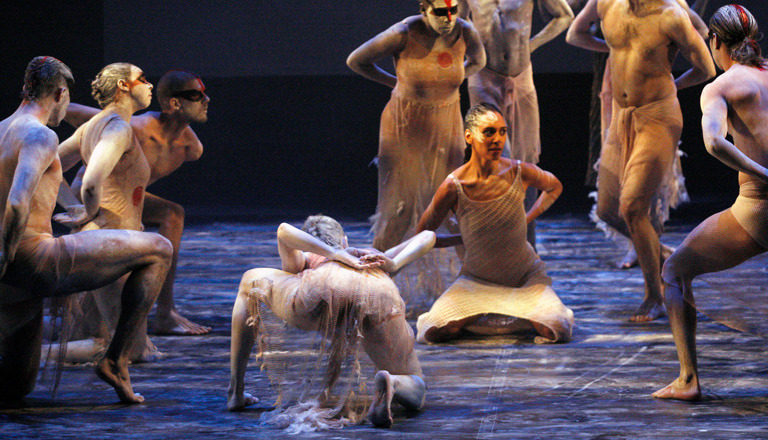Brolga (2001)
After Viewing
FOR YEARS 3/4
Pose questions that remind them of their experience.
- How many dancers are on the stage at the beginning of the dance?
- Where do the first group of dancers come from?
- Are they male or female?
- How many are there in the first group?
- What are they wearing?
- What is on their skin and hair?
- Who has red paint on their head?
- Are all the dancers covered in this?
- What does the mound behind the dancers look like?
- Where do the dancers go and who comes back on stage with them?
- Are they male or female?
- Are there fewer or more dancers this time?
Identify some of the main ideas and select and clarify information from the children’s responses.
- Which dancer do you think is the girl?
- Why do you think the girl is on her own?
- How can you tell she is different?
- What do you think she is doing?
- Why is she is the middle of the circle?
The dance Brolga represents a young woman, who plays with the birds, mimics their movements and learns to respect their sacred knowledge. (To mimic means to copy).
- Why does the girl seem to be following and copying the birds?
- Why and how does she start to look like one of them?
Collect, compare and categorise facts and opinions about brolgas for example, brolga movements are often described as dance movements.
Movement and Meaning
- Do the dancers look anything like the real brolgas?
- Do the dancers move like the brolgas? In what way/s?
- What shape do the five dancers make around the girl?
- Why is the big group of dancers facing the same direction?
- What do you think the dancers’ arms represent when they are long? What do you think they represent when then are bent at the elbows?
Non movement aspects
- Why are the stage lights blue?
- There is a lot of dust on the stage. What do you think it is? What do you think it represents?
- The composer has described the music as a soundscape. Which sounds can you hear? Which are manmade (by musical instruments) and which are natural?
- What is a didgeridoo?
FOR YEARS 5/6
Pose questions that remind them of their experience.
- How many dancers are on the stage at the beginning of the dance?
- In which direction do the first group of dancers move?
- Are they male or female?
- How many are there in the first group?
- What are they wearing?
- What is on their skin and hair?
- Who has red paint on their head?
- Are all the dancers covered in this?
- There is a mound-like prop behind the dancers. What could this represent?
- Where do the dancers go when they move upstage and who comes back on stage with them?
- Are they male or female?
- Are there fewer or more dancers this time?
Identify some of the main ideas and select and clarify information from the students’ responses.
- Which dancer do you think is the soloist?
- Why do you think the soloist is on her own?
- How can you tell she is different?
- What role do you think she is playing in the story?
- Why is she is the middle of the circle?
The dance Brolga represents a young woman, who plays with the birds, mimics their movements and learns to respect their sacred knowledge. (To mimic means to copy).
- Why does the girl seem to be following and copying the birds?
- Why and how does she start to look like one of them?
- What could you learn from watching different animals ?
Collect, compare and categorise facts and opinions, for example, brolga movements are often described as dance movements.
Movement and meaning
- Do the dancers look anything like the real brolgas?
- Do the dancers move like the brolgas? In what way/s?
- Describe/draw the formation that the five dancers make around the ‘girl’?
- Towards which direction is the big group of dancers facing?
- Draw the formations and pathways of the small and large groups.
- Why might they be moving/facing the same direction?
- Describe the movements of the small group of five when they are on a low level.
- Where on the stage is this group placed?
- Describe the movements of the large group. Is there any emphasis placed on any particular movements? (repetition, size)
- Can you see when the dancers are moving in unison? In canon?
- The dancers make special shapes with their bodies, their arms and their elbows. What do you think these shapes represent?
- What is the relationship between the dancers and the audience? Do the dancers acknowledge the presence of the audience or do you get the impression we are onlookers? Why?
Non-movement aspects
- Describe the stage set including the colour of the curtaining, floor, props and the lighting (colour, brightness).
- There is a lot of dust on the stage. What do you think it is? What do you think it represents?
- The music could be described as a soundscape. Which sounds and instruments can you hear?
- The performance is on a stage in a theatre. Is this a traditional or contemporary place for Aboriginal people to dance?
Societies and Cultures
- Djakapurra Munyarryun performed in the opening of the Sydney 2000 Olympics. What role did he play?
- The dance Brolga, created and performed by Bangarra is about growing up, finding meaning in learning and rites of passage. What is a rite of passage?
- What are some other rites of passage experienced in different cultures?
- What are the symbolic stages of a ‘rite of passage’?
- How do rites of passage show what a society values?

